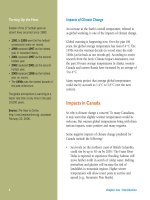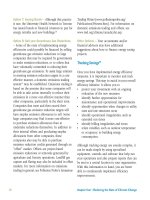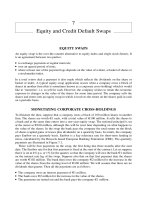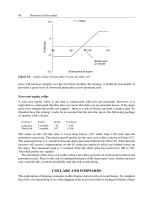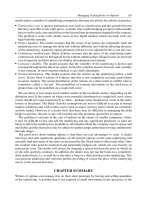STUDY GUIDE FOR COME INTO MY TRADING ROOM phần 5 potx
Bạn đang xem bản rút gọn của tài liệu. Xem và tải ngay bản đầy đủ của tài liệu tại đây (68.29 KB, 20 trang )
Question 83—Elements of Successful Trading*
Which of the following is the single most important factor in successful
trading?
1. Intelligence
2. Experience
3. Discipline
4. Imagination
5. Training
Question 84—Trading Records
All of the following statements about keeping trading records are cor-
rect, except:
1. They are the best reflection of a trader’s discipline.
2. Good records allow traders to be more relaxed with money man-
agement.
3. They are an essential factor in a trader’s success and survival.
4. Good records prevent traders from repeating mistakes.
5. Good records improve traders’ profit/loss ratios.
THE ORGANIZED TRADER 73
*Thanks to Robert Rotella, the title of whose book I borrowed to name this question.
Question 85—Trader’s Spreadsheet
Which of the following records belong in a trader’s spreadsheet?
1. Dates of entries and exits
2. Entry and exit prices
3. Commissions and fees
4. Performance grades
5. Entry and exit grades
A. 1
B. 1 and 2
C. 1, 2, and 3
D. 1, 2, 3, and 4
E. All of the above
Question 86—Trading Equity
Which of the following count as components of equity in your trading
account?
1. Cash in your trading account
2. The total value of open trades
3. Treasury bills held in your trading account
4. Margin credit
5. Reserve savings
A. 1
B. 1 and 2
C. 1, 2, and 3
D. 1, 2, 3, and 4
E. All of the above
74 QUESTIONS
Question 87—Equity Curve
Five traders each start with a $100,000 account. Whose equity curve is
more likely to draw the attention of fund managers?
1. End with $119,000, biggest drawdown $7,600
2. End with $98,000, biggest drawdown $4,100
3. End with $74,000, biggest drawdown $51,000
4. End with $134,000, biggest drawdown $28,000
5. End with $114,000, biggest drawdown $2,800
Question 88—Trading Diary
What is the optimal number of charts in a trading diary?
1. One for entry and one for exit
2. Two or three for entry and one for exit
3. One for entry and two or three for exit
4. Two or three for both entry and exit
5. Five or more for both entry and exit
THE ORGANIZED TRADER 75
Question 89—Trading Diary
Which of the following phrases about a trading diary are correct?
1. Allows you to learn from mistakes and successes
2. Reduces the emotionalism in trading
3. Serves as a precise indicator of your discipline
4. Must be done for every trade
5. Should be done for the most interesting trades
A. 1
B. 1 and 2
C. 1, 2, and 3
D. 1, 2, 3, and 4
E. All of the above
Question 90—Entry and Exit Grades
A trader buys a stock at 47 on the day when the high is 48 and the
low is 44. He sells it a few days later at 51, on the day when the high
is 54 and the low 50. What is his entry grade for this trade? What is
his exit grade?
1. 0%
2. 25%
3. 50%
4. 75%
5. 100%
76 QUESTIONS
Question 91—Trading Decisions
Why is it easier to make trading decisions when the markets are closed?
1. The opportunity to pause, think, and return to your charts later for
another look
2. Lack of pressure from prices moving while you analyze them
3. The ability to compare your stock with many other stocks and indexes
4. The ability to review advisory newsletters
5. The ability to ask other traders for advice
A. 1
B. 1 and 2
C. 1, 2, and 3
D. 1, 2, 3, and 4
E. All of the above
Question 92—Action Plan
Match the following phrases about an action plan:
1. Writing down chart descriptions
2. Writing down what to do in the day ahead
3. Writing descriptions before plans
4. Reading from a sheet while placing orders
5. Specifying your trading size
A. Having to explain what factors led to a trading decision
B. Planning while the market is closed
C. Being clear on facts before moving to their interpretations
D. Adhering to your money management discipline
E. Avoiding emotional mistakes while placing orders
THE ORGANIZED TRADER 77
Question 93—Trading Records
Which of the following records are essential for successful trading?
1. Trader’s spreadsheet
2. Equity curve
3. Trading diary
4. Action plan
5. ABC rating system
A. 1
B. 1 and 2
C. 1, 2, and 3
D. 1, 2, 3, and 4
E. All of the above
Question 94—Second-Guessing Systems
Second-guessing a trading system:
1. Leads to decisions not ordered by the system
2. Increases the range of choices available to a trader
3. Improves the chances of success
4. Is a sign of psychological strength
5. Leads to more disciplined trading
A. 1
B. 1 and 2
C. 1, 2, and 3
D. 1, 2, 3, and 4
E. All of the above
78 QUESTIONS
Question 95—Disclosing Trades
Talking about open positions:
1. Invites advice from other traders
2. Makes you more popular with other traders
3. Helps you see options you have not considered
4. Increases the likelihood of a successful trade
5. Increases the likelihood of long-term success
A. 1
B. 1 and 2
C. 1, 2, and 3
D. 1, 2, 3, and 4
E. All of the above
Question 96—Time Management
Managing time while trading financial markets involves:
1. A weekly review of all markets in which you have any interest
2. A daily review of all markets in which you have open positions
3. Preparing a timetable of earnings reports for the stocks you own
4. Watching the openings of all markets you consider entering
5. Watching the closings of all markets you consider exiting
A. 1
B. 1 and 2
C. 1, 2, and 3
D. 1, 2, 3, and 4
E. All of the above
THE ORGANIZED TRADER 79
Question 97—The ABC Rating System
Match the following phrases about the ABC rating system:
1. May trade this market tomorrow
2. A quick overview of all markets
3. Not likely to trade this market this week
4. An in-depth review of a few markets
5. May trade this market in a few days
A. Group A
B. Group B
C. Group C
D. Done daily
E. Done weekly
Question 98—The Decision-Making Tree
Which of the following combinations fits most closely with a discretion-
ary trader’s decision-making tree?
1. Flexible analytic rules, flexible use of multiple timeframes, flexible
money management rules
2. Strict analytic rules, strict use of multiple timeframes, strict money
management rules
3. Strict analytic rules, strict use of multiple timeframes, flexible money
management rules
4. Flexible analytic rules, flexible use of multiple timeframes, strict
money management rules
5. Flexible analytic rules, strict use of multiple timeframes, flexible
money management rules
80 QUESTIONS
Question 99—Trading Priorities
Which of the following best describes the order of priorities for a serious
trader?
1. Extraordinary profits, steady profits, survival
2. Survival, steady profits, extraordinary profits
3. Steady profits, extraordinary profits, survival
4. Survival, extraordinary profits, steady profits
5. Extraordinary profits, survival, steady profits
Question 100—Trading Career
What is the best sequence for developing a long-term trading plan?
1. Develop a decision-making tree, set money management rules, keep
records
2. Keep records, develop a decision-making tree, set money manage-
ment rules
3. Set money management rules, keep records, develop a decision-
making tree
4. Develop a decision-making tree, keep records, set money manage-
ment rules
5. Keep records, set money management rules, develop a decision-
making tree
THE ORGANIZED TRADER 81
PART
TWO
ANSWERS AND
RATING SCALES
ONE
FINANCIAL TRADING FOR
BABES IN THE WOODS
Answer 1
A. 2, 6
B. 3, 5
C. 1, 4
Give yourself a point for each correct answer.
Researching a stock’s prospects and its industry group is a hallmark
of a serious investor. An insider is the ultimate investor, albeit a crimi-
nal, because he is acting on a fundamental factor likely to move a stock.
The closeness of insider trading to fundamental analysis is an endless
source of embarrassment for many brokerage firms. A trader focuses on
the response of prices to the fundamental data, including mass hysteria.
A gambler who gets his tips from some famous guru on TV is still a gam-
bler because he chases hot leads instead of thinking for himself.
Answer 2
True. 2, 5
False. 1, 3, 4
Give yourself a point for each correct answer.
85
Traders often focus on feelings rather than maximizing profits. A
trader who buys a runaway stock out of fear of missing a good thing is
hardly being rational. Professionals do not expect to win in every trade
and are aware of a great deal of noise and uncertainty in the markets;
they do expect to be profitable in the long run, thanks to steady disci-
plined trading. When a group agrees that a certain trade looks good, it
is usually time to go the other way because groups tend to be more
emotional than individuals. Boiling markets are less rational, creating
opportunities for calm pros; quiet markets are more efficient, making it
more difficult to take money from others.
Answer 3
1. E
2. D
3. B
4. C
5. A
Give yourself a point for each correct answer, with a bonus point if you
got #4 right.
Any fool can enter a trade (and often does), but it takes knowledge
and experience to find good exit points. Entries have to be planned in
advance. An intelligent trader decides he will enter after the market
does what he expects it to do, and then waits for all his ducks to get in
a row. A momentum trader tries to catch an impulse move, a counter-
trend trader a return to value; both methods can be profitable, as long
as you know clearly what it is you are trying to do each time. While
analyzing prices and indicators, you should not forget that money
management is the essential element of trading; each trade has to be
chosen in accordance with strict money management rules.
86 ANSWERS AND RATING SCALES
Answer 4
1. C
2. A
3. A, B, C
4. B, C
5. A, B, C
Give yourself a point for each completely correct answer.
Options are deadly for most buyers who must jump through three
hoops, correctly choosing the vehicle, price, and time. A stock makes
you a part owner of a business, whereas both futures and options deal
in contracts for future delivery and allow you to get out of your com-
mitment before the due date. A trader with no money management
skills will lose in every market, but his loss will come sooner in options
or futures than in stocks. The trend is your friend in every market; there
is no point in buying when prices are falling.
Answer 5
1. A, B, C
2. C
3. B
4. D
5. A
Give yourself a point for each completely correct answer.
Dripping water shapes mountains, and commissions, slippage, and
expenses shape traders’ accounts, affecting them more in the long run
than most trades. Commissions are set by brokers, and slippage can often
be avoided, but expenses can be controlled by traders. Slippage is the dis-
FINANCIAL TRADING FOR BABES IN THE WOODS 87
tance between the market order and the transaction price; it is small in
quiet markets, greater in boiling markets. No expense is meaningless—
they all raise barriers to your success. Commissions and, at times, slip-
page are what you pay for the privilege of entering a trading arena, and
their combination cannot be reduced below a certain minimum.
Answer 6
5. Give yourself five points for choosing the correct answer.
An important survival factor is the maximum percentage of the account
risked on any given trade. It would take a string of 50 losses to knock
traders 4 and 5 out of the game, but a mere five losses can dispatch
trader 3. A bigger account offers several advantages: the cost of services
eats up a smaller percentage and diversification is easier.
Answer 7
C. 3 and 4. Give yourself five points for choosing the correct answer,
or two points if you answered B (one correct out of two).
Earnings are important, but the market’s reaction to them is even
more telling. When a stock refuses to decline after a bad earnings
report, it shows that the bottom is near. A steep drop after a mildly dis-
appointing earnings report indicates further weakness ahead. Futures
can fall below the cost of production when desperate producers dump
their overstock, but they cannot stay there for long. Real-time data only
distracts beginners, as does watching a multitude of markets. Weekly
charts provide the essential long-term perspective, while the best soft-
ware in the hands of a yahoo is useless because knowledge and skills
carry more weight than any tools.
88 ANSWERS AND RATING SCALES
Answer 8
A. 1
B. 3
C. 5
D. 2, 4
Give yourself a point for each correct answer.
Fundamental analysts study supply and demand, which drive prices
in the long run. Market technicians try to read the behavior of the mar-
ket crowd. Both can be used for making trading decisions, although
fundamentals are more important for long-term investors and technicals
for short-term traders. Neither predicts future prices; they tell you what
is happening in the markets now and leave you to decide how to play
the odds for the future. Neither can be automated any more than den-
tistry or driving can be automated.
Rating Yourself
Below 31 Poor. Do not despair, you are just starting to test yourself. Go
back, reread the recommended literature, and then retake this test.
31–36 Fairly good. You have grasped the basic ideas. Look up the
answers to the questions you have missed. Review them and retake
this test in a few days.
37–41 Excellent. Armed with this understanding, you are ready to
move up and tackle the 3 M’s of successful trading.
Required Reading
Elder, Alexander. Come into My Trading Room (New York: John Wiley
& Sons, 2002). See Part One “Financial Trading for Babes in the
Woods.”
Additional Reading
Elder, Alexander. Trading for a Living (New York: John Wiley & Sons,
1993). See “The Odds Against You” (pages 6–11).
FINANCIAL TRADING FOR BABES IN THE WOODS 89
TWO
MIND—
THE DISCIPLINED TRADER
Answer 9
C. 2 and 5. Give yourself five points for choosing the correct answer,
or two points if you answered B (one correct out of two).
There is only one rational reason to trade—to make money, or to be
more exact, to beat riskless rate of return, such as Treasury bills. Trading
as an escape from boredom tends to be a very expensive pastime.
Discipline and determination are more important than intelligence. As
Churchill once said, “It is not the size of the dog in the fight, but the size
of the fight in the dog.”
Answer 10
A. 4
B. 1, 2
C. 3
Give yourself a point for each correct answer.
Your broker said the stock goes up before a split? Why not get the his-
tory of its splits and check for yourself? If you cannot find that history,
you have no business trading. The rate of return on an advisor’s model
portfolio is good for daydreaming but has little connection to how much
you will lose taking his advice next year. The Fed announces its meet-
91
ings well in advance, and you should know that and be ready, reducing
your positions if uncertain about the trend. A stock at its two-year low
is in a downtrend and may hit a three-year low next; a trend in force is
likely to continue.
Answer 11
C. 1, 2, and 3. Give yourself four points for answering C, or two points
for any other answer.
Ignorance is the bane of beginners, but a person who keeps losing
has to look inward and search for a self-destructive streak. Under-
capitalized traders cannot practice sound money management, which
is essential for success. Markets are full of bad advice, but it is your
responsibility to tell the good from the bad or stand aside if you are not
sure.
Answer 12
3. Give yourself three points for choosing the correct answer.
Active alcoholics and losers are in denial, not seeing the depth of
their downfall. To help a loser or an alcoholic break through denial is
to do him a favor. Overstressed losers often develop physical problems,
although not nearly as severe as chronic alcoholics.
Answer 13
1. C
2. B
3. A
4. D
Give yourself a point for each correct answer.
92 ANSWERS AND RATING SCALES
